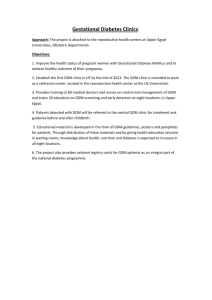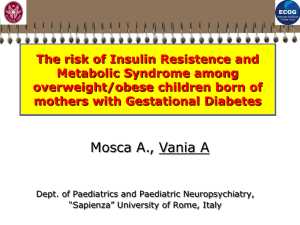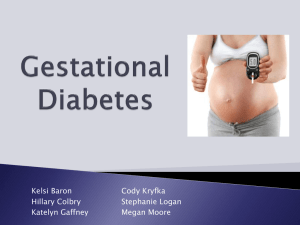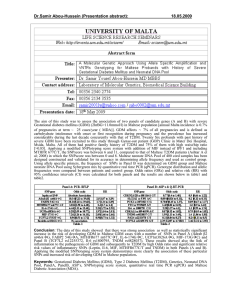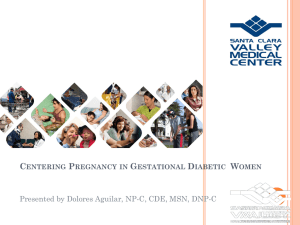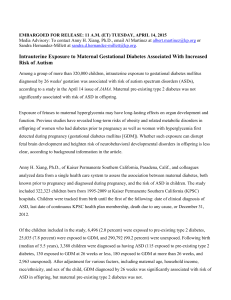The Outcome of Gestational Diabetic Pregnancies in the Maltese Islands
advertisement
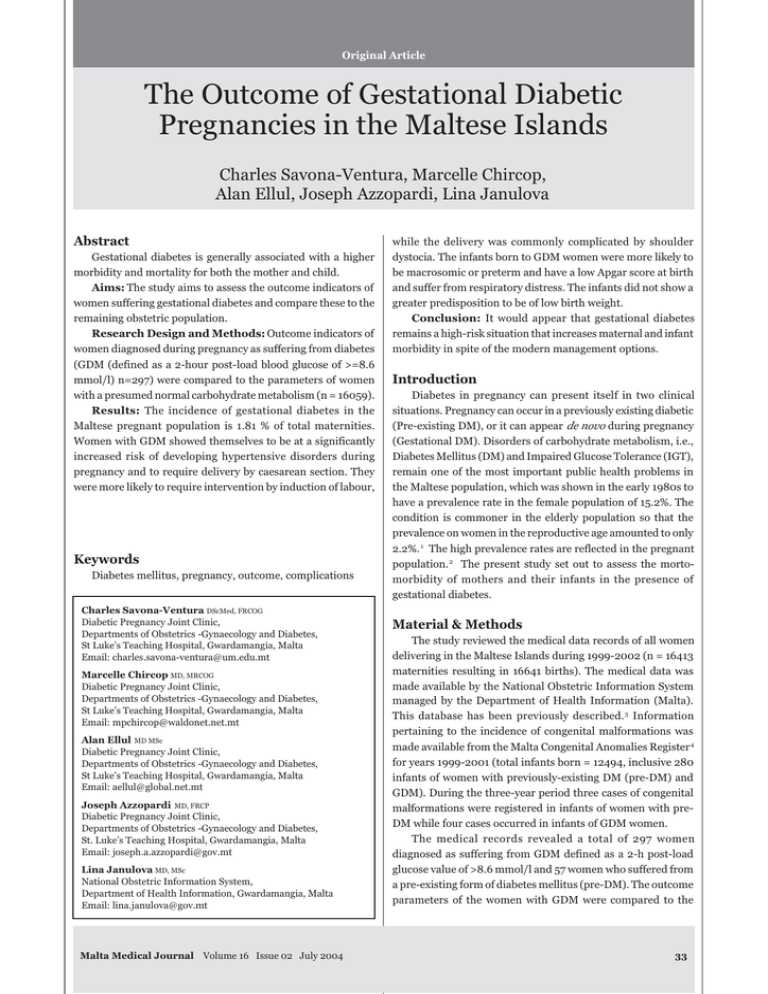
Original Article The Outcome of Gestational Diabetic Pregnancies in the Maltese Islands Charles Savona-Ventura, Marcelle Chircop, Alan Ellul, Joseph Azzopardi, Lina Janulova Abstract Gestational diabetes is generally associated with a higher morbidity and mortality for both the mother and child. Aims: The study aims to assess the outcome indicators of women suffering gestational diabetes and compare these to the remaining obstetric population. Research Design and Methods: Outcome indicators of women diagnosed during pregnancy as suffering from diabetes (GDM (defined as a 2-hour post-load blood glucose of >=8.6 mmol/l) n=297) were compared to the parameters of women with a presumed normal carbohydrate metabolism (n = 16059). Results: The incidence of gestational diabetes in the Maltese pregnant population is 1.81 % of total maternities. Women with GDM showed themselves to be at a significantly increased risk of developing hypertensive disorders during pregnancy and to require delivery by caesarean section. They were more likely to require intervention by induction of labour, Keywords Diabetes mellitus, pregnancy, outcome, complications Charles Savona-Ventura DScMed, FRCOG Diabetic Pregnancy Joint Clinic, Departments of Obstetrics -Gynaecology and Diabetes, St Luke’s Teaching Hospital, Gwardamangia, Malta Email: charles.savona-ventura@um.edu.mt Marcelle Chircop MD, MRCOG Diabetic Pregnancy Joint Clinic, Departments of Obstetrics -Gynaecology and Diabetes, St Luke’s Teaching Hospital, Gwardamangia, Malta Email: mpchircop@waldonet.net.mt Alan Ellul MD MSc Diabetic Pregnancy Joint Clinic, Departments of Obstetrics -Gynaecology and Diabetes, St Luke’s Teaching Hospital, Gwardamangia, Malta Email: aellul@global.net.mt Joseph Azzopardi MD, FRCP Diabetic Pregnancy Joint Clinic, Departments of Obstetrics -Gynaecology and Diabetes, St. Luke’s Teaching Hospital, Gwardamangia, Malta Email: joseph.a.azzopardi@gov.mt Lina Janulova MD, MSc National Obstetric Information System, Department of Health Information, Gwardamangia, Malta Email: lina.janulova@gov.mt Malta Medical Journal Volume 16 Issue 02 July 2004 while the delivery was commonly complicated by shoulder dystocia. The infants born to GDM women were more likely to be macrosomic or preterm and have a low Apgar score at birth and suffer from respiratory distress. The infants did not show a greater predisposition to be of low birth weight. Conclusion: It would appear that gestational diabetes remains a high-risk situation that increases maternal and infant morbidity in spite of the modern management options. Introduction Diabetes in pregnancy can present itself in two clinical situations. Pregnancy can occur in a previously existing diabetic (Pre-existing DM), or it can appear de novo during pregnancy (Gestational DM). Disorders of carbohydrate metabolism, i.e., Diabetes Mellitus (DM) and Impaired Glucose Tolerance (IGT), remain one of the most important public health problems in the Maltese population, which was shown in the early 1980s to have a prevalence rate in the female population of 15.2%. The condition is commoner in the elderly population so that the prevalence on women in the reproductive age amounted to only 2.2%. 1 The high prevalence rates are reflected in the pregnant population. 2 The present study set out to assess the mortomorbidity of mothers and their infants in the presence of gestational diabetes. Material & Methods The study reviewed the medical data records of all women delivering in the Maltese Islands during 1999-2002 (n = 16413 maternities resulting in 16641 births). The medical data was made available by the National Obstetric Information System managed by the Department of Health Information (Malta). This database has been previously described. 3 Information pertaining to the incidence of congenital malformations was made available from the Malta Congenital Anomalies Register 4 for years 1999-2001 (total infants born = 12494, inclusive 280 infants of women with previously-existing DM (pre-DM) and GDM). During the three-year period three cases of congenital malformations were registered in infants of women with preDM while four cases occurred in infants of GDM women. The medical records revealed a total of 297 women diagnosed as suffering from GDM defined as a 2-h post-load glucose value of >8.6 mmol/l and 57 women who suffered from a pre-existing form of diabetes mellitus (pre-DM). The outcome parameters of the women with GDM were compared to the 33 Results Table 1: Incidence rates of gestational diabetes GDM Number % GDM cases Clinically suspect GDM 28 Previous GDM 26 Severe GDM 76 Mild GDM 167 The incidence of identified GDM during the period 19992002 was 1.81% (Table 1). The age-specific GDM rates appeared to progressively increase from 0.78 % in the <25 years age group to 2.14 % in the 25-34 years age group and 4.25% in the >35 years age group (p<0.0001). GDM has been repeatedly associated with maternal and infant complications that contribute towards an adverse maternal and perinatal outcome. GDM was significantly associated with increased rates of maternal pregnancy-induced hypertension and pre-eclampsia. These women were also significantly more likely to require intervention to terminate the pregnancy by resorting to induction of labour and deliver by caesarean section (Table 2). While there appeared to be a progressive increase in multiple pregnancy rates in GDM women, the differences were not statistically significant. More than half (62.3% n=185) of the GDM pregnant patients received structured follow-up, however only 4.7% (n=14) of the GDM women received insulin supplementation during the course of their pregnancy. Eight cases (2.7%) had carbohydrate metabolism abnormalities persisting in the postpartum period. The altered metabolic state brought on by GDM is associated with a predisposition to an adverse effect on the neonate. Infants % total maternities 9.43 8.75 25.59 56.23 0.17 0.16 0.46 1.02 parameters of women with presumed or confirmed normal carbohydrate metabolism (n = 16059). Glucose tolerance testing is not routinely carried out on all maternities but only in those women who are considered at particular risk of GDM. During the study period, 7.2 % of women were thus assessed during the third trimester of pregnancy. From prevalence studies, it is estimated that about 30.7 % of GDM women are thus identified. The group of patients presumed to have normal carbohydrate tolerance thus included a small proportion of patients, estimated as about 4.2 %, with mild degrees of GDM. Statistical significance was tested using the Chi Square test analysis using WHO StatCalc statistical package. A probability value of <0.05 was taken to represent a significant correlation. Table 2: Maternal Outcome Parameters Parameter Multiple births Maternal PIH/PET Induction of labour Caesarean section Operative vaginal delivery Total Normal metabolism GDM Number % Number % P value 210 1032 5916 3806 571 1.3 6.4 36.8 23.7 3.6 8 50 153 109 15 2.7 16.8 51.5 36.7 5.1 0.0751 <0.0001* <0.0001* <0.0001* 0.2288 16059 297 Table 3: Infant Outcome parameters Parameter [1] Normal metabolism GDM Number % Number % P value Multiple births 2nd trimester fetal loss Fetal & neonatal loss Low birth weight [<2.5 kg] Preterm birth [<37 weeks] Infant with RDS Macrosomia [>4.0 kg] Shoulder dystocia Apgar <=6 @ 5 min Congenital anomalies 210 N/A 159 1019 1018 335 927 63 188 460 [1] 1.3 8 0 2 22 34 13 37 12 7 4 2.7 0.7 7.4 11.4 4.4 12.4 4.0 2.3 1.3 0.0751 n/a 0.7980 0.5485 0.002 0.015 <0.0001* <0.0001* 0.053 0.043 Total 16111 1.0 6.3 6.3 2.2 5.7 0.4 1.2 3.8 299 based on 1999-2001 data [total infants = 12214] 34 Malta Medical Journal Volume 16 Issue 02 July 2004 born to GDM women show a greater predisposition towards prematurity, a lowered Apgar score and respiratory distress at birth. The risks of macrosomia were also statistically increased in infants born to GDM women, this being associated with a statistically increased predisposition towards shoulder dystocia. They did not show a greater predisposition to a low birth weight. There also did not appear to be any increased risk of antenatal or neonatal loss (Table 3). An inverse statistical significance predisposition could be demonstrated in the predisposition towards the development of major congenital anomalies. Discussion Gestational diabetes remains one of the most significant obstetric complications in the Maltese population affecting about 1.81 % of the pregnant population. The observed figure is significantly less than the previously reported prevalence of 5.9% identified by cross-sectional studies.2 The difference suggests that the present screening methods in force in Malta are effective at identifying only about 31 % of expected cases of GDM. The current screening measure in force is to screen individuals with a 75-g OGTT whenever these are identified as high-risk on the basis of their anthropomorphic features, past obstetric and gynaecological history, family history, and antenatal clinical indicators. Since the large majority of severe cases of GDM are being regularly identified the use of “historical-clinical” risk criteria is still considered a cost-effective measure in the Maltese situation.5 There have been major developments in the care of the pregnant diabetic that has led to a fall in perinatal deaths attributable to the diabetic problem. However, adverse maternal and neonatal outcomes are still associated with the pregnant diabetic woman. The diabetic pregnancy remains fraught with risks for the mother through the greater predisposition towards hypertensive disease of pregnancy and pre-eclampsia; and is furthermore associated with a greater morbidity brought on by obstetric interventions. The infant of the diabetic mother similarly suffers from a higher morbidity in the form of a high birth weight and the associated complications of prematurity. The inability to equate maternal and infant morbidity of GDM pregnancies to non-diabetic ones emphasizes the difficulties faced in attempting to achieve the goal set by the 1989 St. Vincent’s Declaration that aimed “To achieve a pregnancy outcome in the diabetic woman that approximates that of the non-diabetic woman”. 6 Vigilance needs to be maintained to ensure that the metabolic control of the diabetic patient remains optimal. The maintenance of optimal metabolic control will remain an undertaking that requires the joint co-operation of the patient and the medical team, even in those women who develop GDM, usually in the third trimester of pregnancy. These women can often be adequately controlled by strict dietary regimens that include restriction of refined sugars. Those women with Malta Medical Journal Volume 16 Issue 02 July 2004 persisting elevated levels of blood glucose should be suitably managed by the introduction of hypoglycemic agents. While the rate of insulin use in Maltese women with GDM appears to be particularly low when compared to other centers in Europe, the macrosomia rate in these women appears similar to the reported median European rates. 7 It is possible that insulin, even when introduced freely, is not the ideal therapeutic option for GDM where insulin resistance predominates. The use of oral hypoglycaemic agents, particularly those that act by promoting peripheral glucose utilization (eg metformin, thiazolidinedione) or by augmenting insulin secretion (eg sulphonylureas, meglitinide), should be further investigated since these agents may provide a therapeutic option that is both safe and effective. Oral hypoglycaemic agents have been arbitrarily precluded from use during pregnancy because of the fear of structural or physiological teratogenesis, a belief that they are ineffective during pregnancy, and a fear of maternal side-effects. Few adequate clinical studies have been carried out, but the evidence seems to suggest that oral hypoglycaemic agents, particularly those belonging to the second-generation sulphonylurea group of compounds, have positive therapeutic outcomes in pregnant women.8-10 References 1. Katona G, Aganovic I, Vuskan V, Skrabalo Z: The National Diabetes Programme in Malta - Final Report Phases I & II. WHO.NCD/OND/DIAB/83.2, WHO, Geneva, +115p., 1983. 2. Savona-Ventura C, Schranz AG, Chazan B: The clinical significance of gestational impaired glucose tolerance in the Maltese population. Arch Perinatal Med, 1997; 3(4):55-64 [the prevalence rates have been reviewed to calculate the new diagnostic criteria of a 2-h post-load glucose value of >8.6 mmol/l]. 3. Savona-Ventura C, Janulova L: The computerization of maternity information in a small island community - The Malta experience 1981-1997. Arch Perinatal Med, 1998; 4(4):92-96. 4. Gatt M: Congenital Anomalies Register - Infants/Fetuses Registered 1993-2001 and Major Birth Defects Registered 19932001. Department of Health Information, Malta, 2003 [available at http://www.health.gov.mt/ministry/dhi/mcar.htm; data for 2002 not published]. 5. Savona-Ventura C, Azzopardi J, Sant R. Risk factors for gestational Diabetes Mellitus in the Maltese population: a population based study. Int J Risk and Safety in Med, 2000; 13(1):1-7. 6. Krans HMJ, Porta M, Keen H, (eds.): Diabetes Care and Research in Europe: The St. Vincent Declaration Action Programme. Implementation Document. EURICPCLR 055/3, WHO, Copenhagen, 1992. 7. Hod M, Pfeifer D, Chen R, Perri T: DPAD: Diabetes in Pregnancy Aggregated Data European Pilot Project. Quality Development in Perinatal Care: The OBSQID Project. Report on the Seventh WHO Workshop, Budapest, Hungary, 2-3 November 2001, WHO, Copenhagen, 2002, p.26-29. 8. Langer O, Conway DL, Berkus MD, Xenakis EM-J, Gonzales O. A comparison of glyburide and insulin in women with gestational diabetes mellitus. N Engl J Med, 2000; 343:1134-1138. 9. Greene MF. Oral Hypoglycemic Drugs for Gestational Diabetes. N Engl J Med, 2000; 343:1178-1179 10. Ryan EA. Glyburide was as safe and effective as insulin in gestational diabetes. Evid Based Med. 2001; 6:79-79. 35
